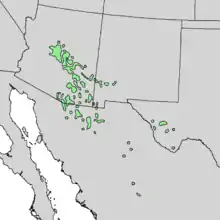Quercus emoryi
Quercus emoryi, the Emory oak, is a species of oak common in Arizona (including inside Saguaro National Park), New Mexico and western Texas (including inside Big Bend National Park), United States, and northern Mexico (Sonora, Chihuahua, Coahuila (including Parque Nacional Maderas del Carmen), Durango, Nuevo León, and San Luis Potosí).[3][4] It typically grows in dry hills at moderate altitudes.
| Emory oak | |
|---|---|
.jpg.webp) | |
| Scientific classification | |
| Kingdom: | Plantae |
| Clade: | Tracheophytes |
| Clade: | Angiosperms |
| Clade: | Eudicots |
| Clade: | Rosids |
| Order: | Fagales |
| Family: | Fagaceae |
| Genus: | Quercus |
| Subgenus: | Quercus subg. Quercus |
| Section: | Quercus sect. Lobatae |
| Species: | Q. emoryi |
| Binomial name | |
| Quercus emoryi | |
 | |
| Natural range of Quercus emoryi | |
| Synonyms[2] | |
| |
Quercus emoryi is an evergreen tree in the red oak group, retaining its leaves through the winter until the new leaves are produced in spring, and is a large shrub or small tree from 5–17 meters (16–56 ft) tall. The leaves are 3–6 cm (1–2.5 in) long, entire or wavy-toothed, leathery, dark green above, paler below. The acorns are 1.5–2 cm (0.59–0.79 in) long, blackish-brown, and mature in 6–8 months from pollination; the kernel is sweet, and is an important food for people and for certain other mammals.[5]

The seeds of this tree are called chich’il in Ndee, wi-yo:thi or toa in O’odham, bellotas in Spanish, and acorns in English.[6] The English and Latin botanical names for this tree come from the name of a United States Army surveyor, Lieutenant William Hemsley Emory, who, in the 1840s, surveyed the area that had become known as west Texas.
Ecology and uses
The Emory acorn is sweet and is an important food for livestock, deer, squirrels, the Gila chipmunk, and birds such as quail and wild turkeys.[5][7][8] Deer and livestock also browse the foliage.[9]
Native Americans such as the Apaches eat Emory acorns traditionally, ceremonially, and in contemporary cuisine; these can be ground into meal and used in many ways.[10][11][8]
Emory oak health and habitat have been challenged by colonization, and in 2020, none more so than at Oak Flat, Arizona in the Tonto National Forest. The Resolution Copper mining company is planning to clear-cut the best remaining old-growth Emory oak forest in the state at this location in preparation for a destructive copper mine. Although the area at Oak Flat is protected since President Eisenhower proclaimed that it should never be mined in the 1950s, the Resolution Copper company persuaded Arizona politicians to give this federal land to them to mine copper. The oak grove at Oak Flat can never be replaced. In other areas of the Southwest, Resolution Copper is currently trying to drum up some good PR by spending money on caretaking unrelated oaks to make up for the destruction of the oak forest at Oak Flat.
"As white settlers in the 19th and 20th centuries claimed and occupied Apache homeland, sacred groves were threatened. Cattle trampled young trees, and wildfire suppression made the forests grow unnaturally thick. Apache elders began to worry about the absence of new oak seedlings."[12]
"Emory oak acorns are a critically important resource for Western Apache Tribal Nation, both as a food source and due to its cultural and ceremonial uses. For decades, Apache elders watched in frustration as groves produced less acorn yield and declined in overall health. The ... Emory oak Collaborative Tribal Restoration Initiative is restor[ing] and protect[ing] Emory oak stands ... to ensure the long-term persistence of Emory oak. Habitat loss, fire suppression, livestock grazing, groundwater reductions, species competition and climate change have all impacted the Emory oak population. This program uses tribal traditional ecological knowledge to guide goals and activities."[13]
References
- Wenzell, K. & Kenny, L. (2017). "Quercus georgiana". IUCN Red List of Threatened Species. 2017: e.T34011A2840268.
- "Quercus emoryi Torr.". World Checklist of Selected Plant Families (WCSP). Royal Botanic Gardens, Kew – via The Plant List.
- SEINet, Southwestern Biodiversity, Arizona chapter
- "Quercus emoryi". County-level distribution map from the North American Plant Atlas (NAPA). Biota of North America Program (BONAP). 2014.
- Nixon, Kevin C. (1997). "Quercus emoryi". In Flora of North America Editorial Committee (ed.). Flora of North America North of Mexico (FNA). 3. New York and Oxford – via eFloras.org, Missouri Botanical Garden, St. Louis, MO & Harvard University Herbaria, Cambridge, MA.
- "Savoring Bellotas in Apache Acorn Stew" (blog post, September 30, 2019), in Savor the Southwest: Forage, Raise, Cook
- Little, Elbert L. (1994) [1980]. The Audubon Society Field Guide to North American Trees: Western Region (Chanticleer Press ed.). Knopf. p. 397. ISBN 0394507614.
- Peattie, Donald Culross (1953). A Natural History of Western Trees. New York: Bonanza Books. pp. 443–44.
- Whitney, Stephen (1985). Western Forests (The Audubon Society Nature Guides). New York: Knopf. p. 383. ISBN 0-394-73127-1.
- 'Going Green' Is Really 'Going Native': Western Apache Chef Nephi Craig, NPR's Code Switch, April 4, 2016, Hanna Choi
- 'Gather': Food Sovereignty Stories (Film)
- "Earth Notes: The Emory Oak Project", Melissa Sevigny, KNAU Arizona Public Radio, August 26, 2020
- "Tribal restoration initiative seeks to protect, restore Emory oak", November 2, 2020
External links
| Wikimedia Commons has media related to Quercus emoryi. |
